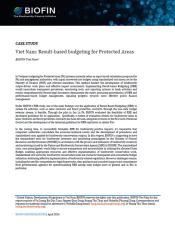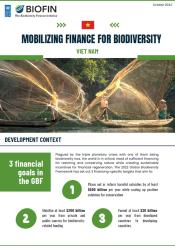Viet Nam
Viet Nam, ranked 16th among the world’s most biodiverse countries and one of the ten richest centers of biodiversity, relies heavily on nature for economic development and the livelihoods of millions. In 2023, sectors like agriculture, forestry, fisheries, and tourism, which are deeply connected to natural resources, contributed approximately 17.5% to the country’s GDP.
For example, Viet Nam’s rich biodiversity, with over 50,000 species spanning across all ecosystems, has also been a significant draw for international tourism. The number of international visitors surged from 5 million in 2010 to 12.6 million in 2023, marking a 3.4-fold increase from 2022 as the country recovered from the COVID-19 pandemic, although still below the earlier peak of 18 million in 2019.
Despite biodiversity’s critical role in the economy, it is in decline.
Overexploitation, habitat degradation, and agricultural expansion have led to alarming rates of species extinction and ecological degradation. For instance, the Dugong, once common in Vietnamese waters, has not been seen since 2016 due to habitat loss and over-hunting.
This biodiversity decline poses a significant threat to Viet Nam’s sustainable development goals.
Although biodiversity is essential for human well-being and environmental health, rapid loss continues, driven by population growth, unsustainable resource use, and insufficient conservation funding. Financial resources for biodiversity conservation are currently inadequate, with biodiversity expenditure representing just 0.16% of GDP and 0.58% of the national budget. Between 2011 and 2015, 4,582,003 million VND (approx. 195 million USD) was spent on biodiversity on average annually, with 76.7% coming from the public sector.
Addressing the global urgency of biodiversity loss, the 2022 Global Biodiversity Framework set ambitious targets, including phasing out harmful subsidies by $500 billion per year and mobilizing at least $200 billion annually for biodiversity-related funding. For Viet Nam, achieving these goals requires a comprehensive approach to biodiversity financing, including increased public and private investment, result-based budgeting, payment/fee schemes, and promoting community financial contribution to local conservation through improved livelihoods.
The objectives of the BIOFIN project in Viet Nam are well-aligned with these global targets and national priorities. BIOFIN aims to assess current financial flows towards biodiversity protection, develop mechanisms to improve financial sustainability, and support the implementation of the National Biodiversity Strategy and Action Plan (NBSAP).
BIOFIN conducted Viet Nam's first review of biodiversity expenditures, providing policymakers with critical insights into the financial flows toward biodiversity conservation, identification of funding gaps, inefficiencies, and opportunities for optimizing budget allocation. On top of that, a financial needs assessment, policy & institutional review, and biodiversity finance plan were developed to provide a roadmap for BIOFIN’s uptakes in Viet Nam.
Refurbished Nature Museum at Cuc Phuong National Park: BIOFIN leveraged public investment of 2.296 billion VND to renovate the Nature Museum at Cuc Phuong National Park, enhancing visitor experiences and generating new income sources for biodiversity conservation.
Result-Based Budgeting (RBB): BIOFIN introduced RBB in the Sao La Protected Area, leading to the development of guidelines for its application in Vietnam’s protected areas, enhancing the efficiency of conservation financing and forest protection activities.
Hon Cau Tourism Fee System: BIOFIN develops a tourism fee system designed to generate revenue for conservation and promote community-based ecotourism. This initiative is expected to create a sustainable revenue stream to support long-term marine conservation efforts.
Fisheries Co-Management in Binh Thuan: BIOFIN works with community co-management groups in Ham Thuan Nam, Binh Thuan, to boost revenues for conservation and support fisher communities. These efforts have empowered local communities to take a more active role in preserving their marine environment.
Coral Protection in Hon Yen: BIOFIN collaborated with local communities to propose a user fee system for coral protection and strengthen community-based ecotourism activities. 15% of the tourism revenues is allocated to the cooperative fund for coral reef protection and community-led patrolling.
Fisheries Resource Protection Fees: BIOFIN initiated a feasibility study and a proposal to implement a financing mechanism for directing fishing-related fees toward conservation. The mechanism is estimated to mobilize $12.7 million annually from fee revenues.
Finance Solution 1: Renovation of the Nature Museum at the Cuc Phuong National Park to improve visitor experiences and generate more visitors’ fees for conservation.
The renovation of the Nature Museum at Cuc Phuong National Park aims to enhance visitor experiences and increase visitor fees, thereby generating additional revenue for conservation efforts.
Finance Solution 2: Development of guidelines, procedures, and standardized costs for biodiversity monitoring and reporting in Viet Nam’s Protected Areas as well as for the application of Result-based budgeting processes.
The development of guidelines and standardized costs for biodiversity inventory in Vietnam’s Protected Areas, alongside the implementation of Result-based budgeting processes, seeks to improve transparency and accountability in government spending on conservation. This solution aims to ensure more effective allocation of resources, reducing financial mismanagement and enhancing biodiversity conservation efforts.
Finance Solution 3: Tourism fee system for Hon Cau Marine Protected Area, Binh Thuan province
The establishment of a tourism fee system at Hon Cau Marine Protected Area is designed to generate revenue for conservation and support community-based ecotourism. If successful, this model could be replicated across other Protected Areas in Vietnam, fostering sustainable tourism practices.
Finance Solution 4: Financial mechanism for sustainable co-management for fishery resources protection in Ham Thuan Nam, Binh Thuan province
The financial mechanism for sustainable co-management of fishery resources in Ham Thuan Nam involves mobilizing various revenue streams to support the conservation of coastal fishery resources. This approach emphasizes the importance of community involvement and aims to enhance the sustainability of co-management models, potentially replicable in other coastal areas.
Finance Solution 5: New user fee system for coral protection in Hon Yen, Phu Yen province
The development of a new user fee system for coral protection in Hon Yen seeks to fund conservation efforts through community-based tourism. This solution aims to control the impact of tourism on coral reefs, promoting sustainable practices and supporting local conservation initiatives.
Finance solution 6: Study for the collection, management, usage of fishery resource protection fees
The study on the collection and management of fishery resource protection fees aims to create a financing mechanism that directs fishing-related fees toward conservation activities. This initiative is expected to secure significant annual funding for marine ecosystem protection, ensuring well-funded conservation work
The aim of the BIOFIN PIR in Viet Nam is to analyze the country’s fiscal, economic, legal, policy, and institutional framework as the baseline for initiating, improving, and scaling effective BD finance solutions. To achieve this, BIOFIN Viet Nam has conducted an analysis of the existing policies, institutional arrangements, and finance actors that drive both positive and negative trends in biodiversity management at the national level in order to identify key drivers and sectors affecting biodiversity. It has validated the analysis through stakeholder consultations, organized workshops finalizing the findings and recommendations, and prepared a synthesis report establishing a baseline context and orientation for the entire BIOFIN process.
A finalized version of the Viet Nam PIR report is now available.
The BER was completed with inputs from various sources at both the national and provincial level, such as: the Ministry of Agriculture and Rural Development (MARD), the Ministry of Natural Resources and Environment (MONRE), the Ministry of Science and Technology (MOST), Provincial Departments of Agriculture and Rural Development (DARDs), Provincial Departments of Natural Resources and Environment (DONREs), National Parks (NPs), Nature Reserves (NRs), etc. All collected data and information was analyzed following the guidance provided in the BIOFIN Workbook (2016). Two consultation workshops were also organized, to collect comments and feedback from relevant stakeholders and interested parties, which were used to frame this final report and its recommendations.
Based on current biodiversity expenditure as presented in the BER, and the suite of strategies and actions based on Viet Nam’s NBSAP and other key national strategies as presented in the PIR, BIOFIN Viet Nam is currently assessing the financial needs (costing) of Viet Nam in order to implement national biodiversity strategies and plans towards achieving the Aichi Targets and national biodiversity objectives, as well as addressing the financial gap associated with the FNA.
The BFP is the culmination of the BIOFIN process, incorporating all the information, evidence, and recommendations set out in the preceding three reports as well as taken from consultations with stakeholders. By presenting an analysis of a set of finance solutions and technical proposals to fill the identified gaps in biodiversity finance, as well as the economic and business case for their implementation, the BFP will serve as a comprehensive guide map for the expansion and amelioration of Viet Nam’s approach to biodiversity finance that encompasses all sectors of society. The draft BFP proposes a list of different financial solutions which will be selected at a later date based on consultations with relevant ministries, provinces, and protected areas.

